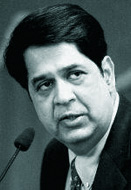During the World Economic Forum in Davos, Switzerland, which ended February 1, Wharton management professor Michael Useem interviewed K.V. Kamath, who has served for more than a decade as chief executive of ICICI Bank, the largest private bank in India and a major player in the Indian economy and beyond. Below is an edited version of the conversation.
Michael Useem: We spoke in 2006 at this event, and at that time, you said that in order for ICICI to break into the top tier of global banks, it would have to leverage India’s rural economy. Has that strategy worked?
K.V. Kamath: That strategy has worked to some extent, but other strategies have worked out better. For example, our strategy to broad-base our business across the world, particularly to try to connect with non-resident Indians, and corporate India, which is going global, gave us momentum during the past two or three years. Now that the global presence of Indian companies is in flux [because of the slowdown], it gives us a good opportunity to return to our rural strategy.
You may wonder why we did not perform better on the rural front in the last three years. There were two reasons. First, our entire rural strategy was based on technology as a disrupter. Technology did become the disrupter, but looking at the advent of mobile technology, we thought that that’s going to be the lowest cost option to reach into the village. Second, in the last three years, the penetration of mobile technology into the village wasn’t as deep as we would have liked it to be. It is getting there now. So we are looking at another 18-month horizon before rural India gets to a position where we can actually deal with the telephone instrument as the default device [for mobile banking].
Useem: To shift gears, let us talk about the fact that you have announced your plan to step down at the end of April. Chanda Kochhar, your chief financial officer will take over as CEO at that point. This major announcement was made in December. I have read that Narayanan Vaghul, your predecessor in the chief executive position, now chair of the board, knew in the first few months after meeting you that you should be his successor. Along those lines, how long did it take you to identify Ms. Kochhar as your successor?
Kamath: There has been a change in the context during the time that Mr. Vaghul thought of me as somebody with the ability to take his place, and the last few years. In recent years, ICICI has become a more broad-based organization; its mission is now on a much broader footing, and there are several business lines. The strategy I adopted during the last 10 to 12 years was to see who could be groomed to grow into what I’d call the leadership context. I wanted to ensure that we had at least four capable people who could be considered possible and potential successors. Each had to be a proven leader in his or her own business. We had people in our various subsidiaries, and we had people within the bank. In the last two years, we further refined the criteria we wanted in this new leader.
One element that I put in — which today, when I look back, seems particularly timely — was to look for somebody who could deal with complexity, shocks and disruptions in a stable way. Typically in most leadership situations, this attribute is not considered to be of the highest importance, but we made it the No. 1 quality. And, of course, all the other leadership traits were also required. So everybody was tested, but as the cone grew narrower on its way to the top, Chanda Kochhar emerged as the leader.
Useem: Could you speak further about that testing process? How did you go about acquiring the information you needed and, of course, the board needed, to decide that Ms. Kochhar was the one? I realize this process probably took 12 or 18 months to go through. Could you explain how you managed the way you gathered information, consulted with your board and made the final decision?
Kamath: There were several elements. The first was what I would describe as “managing the corporate center” — which involved looking at investor relations, the media, external representation of the organization and various profit drivers. I viewed each of these leaders in the context of this framework. At the same time, we started gathering feedback from peers and superiors as well as people around us — including customers and other stakeholders, such as government officials. We exposed these leaders more and more to such situations and continued getting feedback.
This process was not as direct as exposing a person to a situation and then coming back and asking, “How did this person do?” It was much more subtle. When you want feedback about managing the business of the company, you can get feedback very directly — you know whether someone is effective or not. But when you evaluate how someone manages external relationships on behalf of the company, you need to seek out feedback in subtle ways. It is not as structured as getting 360-degree feedback. So we used a combination of structured as well as unstructured mechanisms to gain feedback. We continued this process for a year to a year and a half.
Useem: Describe, if you could, how you consulted with the board, what kind of input they had into the final decision and how they concluded that Ms Kochhar was the right choice.
Kamath: On ICICI’s board the nominations committee, which selects the CEO, is called the governance committee. We started consulting this committee some two years ago. We offered them a slate of leaders. They had seen these leaders in the early years, but we went one step ahead. We decided that leaders who were in consideration for the CEO’s job — even if they were running subsidiary companies — should be invited to attend every board meeting of the holding company, the parent, so that they could interact with the board members. That would give our board members the opportunity to see them firsthand, talk to them about their businesses, and so on. This was done for two years. Every two months, ICICI’s board members got a chance to see all the people who were under consideration for the CEO’s position. Each candidate was explicitly told that this was the process. After that, as the date for naming the new CEO drew closer, the governance committee began considering the various candidates and their attributes. In April 2008, the choices were discussed and that was followed by further discussion at the level of the whole board. After that, we made the decision in the last quarter of 2008.
Useem: ICICI is well known for developing its own leadership talent, which enables you to have this kind of open final look at four, maybe even more, candidates. As we look back, though, to the experience of GE, as it came up with its successor, Jeff Immelt, in 2001, the two other candidates who were finalists for replacing Jack Welch, within days, had left the company. When Indra Nooyi became the chief executive of Pepsi two years ago, her first act as the new CEO was to go to meet with her counterpart — that is, the person who was closest in contest with her to become chief executive — and to plead with him not to leave the company. Would you offer your thoughts on what you did to retain the talent that was under consideration? What steps did you take to keep the other candidates? What would you advise Ms. Kochhar to do to retain the people who were not picked in her place?
Kamath: Every CEO quickly realizes the strengths that various people bring to an organization, and what should be done in that context to keep the organization focused and intact. I’m sure Ms. Kochhar will do the right thing. This is a heavily board-driven organization, and any major action will need to have the nod of the board or governance committee. The governance committee, I’m sure, will also, in that context, keep talking to the CEO. And I’m sure the CEO will do what is in the interests of the organization.
Useem: Let me move to the bigger picture of events around the world during the last few months, as we’ve hit this huge financial crisis. The U.S., in particular, faces a crisis of such a magnitude that some of our banks are close to being nationalized. India has been through that experience back in the 1960s. From your own experience of witnessing that and watching how banks — state banks as well as private banks — in India have operated in the years since, if you were called into the White House to consult with President Barack Obama, what would be your advice about the role of government in nationalizing or keeping banks at arm’s length now in the U.S.?
Kamath: Two issues need to be addressed. The first is investor confidence, and the second is systemic integrity. By systemic integrity, I mean that if you allow a massive failure of the financial system in the U.S., the impact would be felt, not only in the U.S., but in the rest of the world. These two issues are of paramount importance. Within this overall context, the problem could be approached in several different ways.
If you have taxpayer money being used to rescue the banks — whether you call that nationalization or something else — the taxpayers have to get a much better deal than it might have been if you had another investor’s money coming in. For example, consider the issue of large bonuses that have been paid out on Wall Street. In fact, this should have been a pre-condition before public capital was used to bail out the banks. I just cannot understand how the government could put in such large sums of money without any conditions about bonus payments. Bonuses should have been zero. There is this myth that people would leave to go to other jobs, but that was just nonsense. When you are up against such a situation, hard action is required. The terms could even have been, “We will take a look at reasonable compensation.” I am not saying there should be controls. If this is done, you have a structure that is built on trust and which people can support. That is what should have happened in the governance context.
Second, I think the current challenge calls for a good bank-bad bank solution. There is no other way. If you go back a few years to what the Chinese did, it was essentially a good bank-bad bank solution to their banking crisis. Chinese banks had gross EPAs (external payments arrears) equal to 50% of the country’s GDP going back eight years. That situation has been cleaned up — even though hardly anybody knows about it. What they essentially did was to take the troubled assets outside the banking system and say, “The government will tackle these problems.” As for the rest of the assets, the banks were allowed to get on with their business.
Now, China’s situation is slightly different from the U.S., because China was not running a budget deficit. They had a budget surplus, so they could do that. In the U.S. context, I think the government would need to simultaneously work on closing the budget deficit so that credibility in the U.S. currency and the U.S. system is maintained.
Useem: I have a two-part question now, coming back to India, on the impact of the world financial crisis. How is the crisis affecting banking in India? And second, has the crisis affected how you think strategically about where your own bank should be going now?
Kamath: To answer the first part of your question, even though the Indian economy has been opening up, the economic system here is not too integrated with the world. In international trade, exports are just about 17% or 18% of GDP. So while we are impacted by the financial crisis, the situation is not dire. Indian banks have been very conservatively leveraged since 2002. The total capital-to-asset ratio in the Indian banking system is probably eight or so, which is probably among the best in the world. So there are no time bombs sitting there in terms of what could happen.
In terms of our own view of the world, we need a lot more clarity before we go out aggressively with a global push. Several questions need to be answered. For example, will protectionism surface across the world? Will trust be restored — though the rating agencies have effectively failed in what they were doing? We need to understand these issues before we can commit significantly more capital to global businesses. The good news here is that India has a huge domestic opportunity, because the country continues to grow at 7% to 8%. I would say that despite all the problems, this year and next year we are looking at a growth rate of 7% to 7.5%. So we have certainly enough to do back home.
Useem: Let’s stay with this issue of the opportunity within the crisis. As you do look at the next couple of years, what are some of the opportunities that you would not have seen six months ago, but you do see now because of this crisis?
Kamath: The big opportunity is that the crisis has brought along a major correction in global prices. Oil is now at less than one-third of what it was, and that is true of most commodities. To me, this is a huge driver in terms of what will happen in the world. This is very important for a developing country because we are looking at product prices that are just 50% to 60% of what they were six months ago. The opportunity in the global economic crisis is that falling prices can drive growth momentum — and this is especially true for developing countries. It means better opportunities for our companies.
Useem: Let me ask you now about your role as president of the Confederation of Indian Industry. In view of the publicized governance problems and malfeasance at Satyam, what advice would you give to other Indian companies, including your own, on how to respond to the shadow that has been cast across Indian business, at least as it is viewed from outside the country?
Kamath: The first thing that India needs to communicate is the robustness of the entire process, notwithstanding Satyam. The robustness of the process starts with the robustness of financial institutions — in this case, the banking regulators. The second [thing] is the rapid action that the government took, literally, within 48 hours of bringing a new board in. I think it’s a huge signal to the outside world. I have not seen this sort of an action in any other failure that took place in the U.S. We should now give this new board time to see how they will resolve the challenge. I would like to believe it’s a one-off thing that has seen a rapid response from the government, and I think the basic institutional framework which governs [situations like these] is in place.
Useem: If other Indian chief executives come to you in the months ahead and ask you for advice on what they have to do to ensure that their companies have the best governance — both for internal purposes but, also, for purposes of reputation with international investors — in what area would you say governance of many companies in India needs the most work?
Kamath: I think, at the basic level, honestly and transparency. We will have to find a way to communicate that transparency, whether it is through what we publish in our reports, or whether it is the way in which we will seek out monitors and those people who evaluate us. To me, that would be the basic way.
Useem: Mr. Kamath, I’m going to close with two more personal questions. You step down as chief executive at the end of April. What do you do after May 1? You are going to become non-executive chair of ICICI. What does the future hold for you personally?
Kamath: Very simply, I will continue to spend maybe 25% to 35% of my time with ICICI. Secondly, I want to keep one third of the time to myself — that is, to be with my family. I have two growing grandchildren and I want to spend time with them. And in the same 35% of my time, I would like to learn all the things about which I am ignorant. There are a whole lot of things out there which I don’t know [much about] — arts, literature, philosophy, music, dance. I’m an illiterate. I know engineering. I know technology. I know banking. And I know maybe a little bit of leadership — but that’s not the world. There’s a whole lot there. So I need to learn to educate myself. The remaining 30% of my time will go to other public activities, whether at the management level or otherwise. We’ll see as we go along. So break it up into one third, one third, one third.
Useem: I will close on this. You’ve had a distinguished career in banking. You took a stint with the Asian Development Bank. There have been some twists and turns in your own career path. Looking back, what do you consider your most important single career decision along the way?
Kamath: I think the most important single decision along the way was to come back from the Asian Development Bank to India in 1994.



